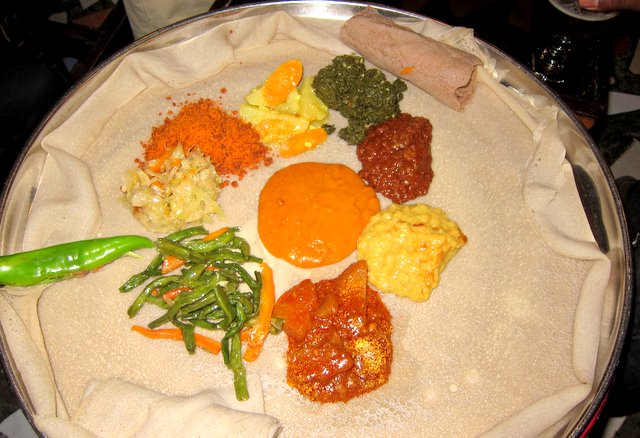Ethiopia
Coming to Ethiopia as a vegetarian, I knew that eating would not be a problem. I can tolerate injera – crepe like thing of the color and taste of a washcloth – which Ethiopians seem to eat with everything.
Vegetarianism itself is not such a foreign concept to Ethiopians even though they don’t necessarily call it by that name. The majority of Ethiopians are Orthodox Ethiopians and they don’t eat meat on Wednesdays and Fridays. On these days, non-meat fasting food can be found easily in restaurants.
But even on non-fasting days, any restaurant can be asked to prepare Shiro (pureed chickpeas in Berber sauce) at a moment’s notice.
Eating Shiro every day does get old every day though (and after a week of it, it can start to look like… nevermind). This is where Bayenetu comes in.
Bayenetu is a collection of meat-free dishes served over a plate of big round injera. Think of a sampler plate. What those dishes are depend on the restaurant. Each prepares it slightly differently:
Some dishes regularly found on Bayenetus include:
Aterkik Alitcha – yellow peas in sauce (my favorite!)
Atkilt Wot – cabbage, carrots, potatoes in sauce
Gomen – collard green cooked to perfection with spices
Misir Wot – pureed red lentil in berbere sauce
One thing they do have in common: shiro is always one of the dishes found on a Bayenetu. So yeah, you can’t escape Shiro altogether.
By the way, a fun thing to do in Addis Ababa is to go to Habesha Restaurant for dinner. They make the best Bayenetu I had in Ethiopia which goes so well with the house’s super strong Tej. Tej is Ethiopian wine made of fermented honey. It’s often served in glass beakers that look like they should belong in a Chemistry lab. Watch out. It packs quite a punch.
Having Tej at Habesha
But the best part of going to Habesha is that you get to see a performance of Ethiopian dances every evening. Audience participation isn’t only encouraged, it’s practically mandatory. Check out the video to get a taste to Ethiopian music.
As a very last resort, spaghetti with tomato sauce is also very commonly served in Ethiopia. Expecting a sad looking pasta drenched in ketchup like sauce, I was constantly surprised. It might be a culinary skill left by the Italians during occupation decades ago, but I had some of the best spaghetti sauce here in Ethiopia. No kidding.
The sauce is always freshly made, a little spicy, and the pasta is always al dente – the way it’s supposed to be.
Fruit wise, I wasn’t too impressed by the varieties (I guess I’m spoiled). Juice of avocado, mango, strawberry, guava can be found in many restaurants. Try a mixed version of everything. It’s colorful and it’s really good. You don’t even need to tell them not to add sugar. Which I did and got a blank look from the waiter as a result. I know what he’s thinking too – ‘Duh, it’s fruit. Why would you add sugar?’ Thank you. Exactly. Can someone tell that to South Americans?
As a vegetarian traveling in Ethiopia, you won’t starve. But the lack of varieties can get to you after awhile. Thankfully, rumor has it Addis Ababa does have a few international restaurants like Thai (unable to find it), Indian (still an uncorroborated rumor), and I even saw a sign once for a Japanese restaurant (on Haile Gebrselassie Rd towards the airport if you’re so inclined to look for it). Finding them is a different matter.
(They don’t use street numbers, you can have to go by landmarks which makes finding anything feel like a treasure hunt.)
An unexpected side-effect of too much Ethiopian food?
I woke up one day and all I could think about was how to get my hands on a basket of fish and chips. Afterwards, I drooled at the thought of Mc Donald’s Egg McMuffin and hashbrowns. Then I thought of pizzas. I don’t even like pizzas.
See, Ethiopian food seems to be so low in fat and salt that after 2 weeks I craved for something just completely the opposite. The greasier the better. Thankfully, it was easily fixed by a quick stroll to Kaldi’s Coffee (Ethiopian version of Starbucks).
French fries and tiramisu never tasted sooo good. I even went for seconds. I guess there’s such a thing as too much of a good thing after all.







Questions and Comments
Comments are disabled. If you have any questions about the post, you can DM me on Instagram: @jacknjilltravel.